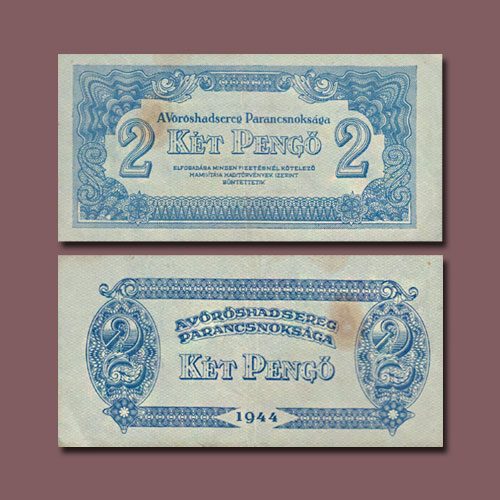Hungary 2 Pengo banknote of 1944
2019-12-11 Wed
Hungary is a landlocked country in Central Europe. Its capital, Budapest, is bisected by the Danube River. Its cityscape is studded with architectural landmarks from Buda’s medieval Castle Hill and grand neoclassical buildings along Pest’s Andrássy Avenue to the 19th-century Chain Bridge.The pengo was the currency of Hungary between 1 January 1927 and 31 July 1946. It was replaced the korona, which in turn was replaced by the forint. The pengo was subdivided into 100 filler. Although the introduction of the pengo was part of a post-World War I stabilisation program, the currency survived for only 20 years and experienced the most serious case of hyperinflation ever recorded. The first series of pengo banknotes were printed in 1926.
During the 2nd World War, in 1944, during the Soviet occupation of Hungary, the Red Army issued paper money without cover in the areas under its control. These banknotes were of poor quality, and aggravated the inflation of the pengo.
Today we are looking at one such banknote issued by the Soviet Red Army. The note depicted beside is a 2 Pengo banknote. This note has the denomination on its obverse with legend in Hungarian reading “Command of the Red Army” and a warning against counterfeiting. Similarly the reverse has the denomination value with Hungarian legend, “Command of the Red Army”.
Image Courtesy: eBay.com
Latest News
-
Malwa Sultan Mahmud Shah Silver Coins
2025-09-11 ThuMalwa Sultan Mahmud Shah minted silver coins in round and square flans. <br><br> For round coins,...
-
Malwa Sultan Mahmud Shah Billon coin
2025-08-26 TueMalwa Sultan Mahmud Shah's billon coins followed three weight standards: 100 rati, 96 rati, and 80 r...
-
Fascinating Archaeological Facts on Postage Stamps - 91
2025-08-23 SatRhinoceros is one of the oldest land mammal species existing in India. There are five species of rhi...
-
Fascinating Archaeological Facts on Postage Stamps - 90
2025-08-23 SatUthiramerur, a Village in Kanchipuram, Tamil Nadu, is notable for its Temple inscriptions that descr...
-
Fascinating Archaeological Facts on Postage Stamps - 89
2025-08-21 ThuThe term “millet” is derived from the Latin word “milum,” which translates to grain. millets...

